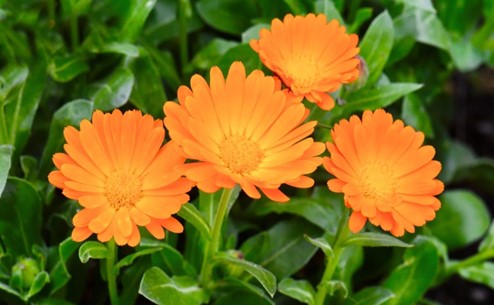
Latin: Calendula officinalis L.
English Name: Calendula, Pot marigold
It is native to the Middle East and Southern Europe; cultivated in the Balkans, North America, Eastern Europe, Germany and Turkey. It is annual in cold regions and perennial in warm and temperate regions. The stem of the plant, lignified only at the base, reaches a height of 20 cm when green and 30-40 cm when in flower. The lanceolate flowers are usually 2 cm, orange or egg-yellow or orange-yellow, dry shiny. Tubular flowers are 15-20 mm, usually yellow, orange red, red-violet, sometimes brown. It is a versatile plant that can be grown in almost any sunny location in almost any soil.
It is grown as annual or perennial depending on the climate. Its hairy and green colored leaves grow up to 20 cm. It forms many stems from the top of the soil. Side branches are formed from these stems. Flower clusters are located at the ends of the side branches. Since it is a foreign fertilized plant, the flowers are quite different in color and shape. During the full yield period, the plant can reach a diameter of 30 cm. In this period, it can grow up to 40 cm in fertile soil. The flowers are covered with a sticky and waxy substance. For this reason, it can hold the dust around. The places where the plant is cultivated should be clean.
Calendula can bloom all year round in mild and warm climates. However, in cold regions, it blooms in spring, summer and early fall, and in late fall and winter, the plant is damaged by cold and dies. For this reason, it is grown as a perennial in mild climates and as an annual in cold regions. The seeds are quite large and these seeds are sown directly in the field or transplanted into seedlings and planted in the field. Seedlings can be planted in the field approximately 20-30 days after sowing the seeds. As planting density, 40x20 cm row spacing and distances are suitable. In this way, 12.000 seedlings can be planted per decare. Very fast growing plants start to bloom about 1 month after planting. The plant continuously forms new flower buds and blooms throughout the growing period. These flowers are collected weekly when they are fresh. Approximately 300 kg of fresh flowers and 150 kg of dried flowers can be obtained from the decare.
It contains mono, sesquiterpenes, triterpenes, phenol acids, flavonoids, tannins and carotenoids. It also has antifungal, anti-inflammatory and antibacterial properties. Essential oil (0.97%), amino acids, fats and fatty acids, calendin and calendulin as bitter substances
Cosmetics: foundation, blush, eye shadow, moisturizer, soothing skin cream, hair serum, shampoo, perfume
Food Supplements: Food supplements for flavors, salads and soups
Beverage Flavoring: Herbal tea, aroma
Pet Health, Food, Cosmetics: Skin and first aid products
Herbal Medicine: Wound healing, eczema prevention, inflammation relief
Cleaning: Soap
Extract Form: Liquid
Active ingredients: α-cadinol, γ-cadinol, γ-cadinol, viridiflorol, τ-cadinol, (3.3-5.6%) and γ -muurolen, flavonoids, triterpenoids, glycosides, saponins, carotenoids, essential oils, amino acids, steroids, sterols and quinines






